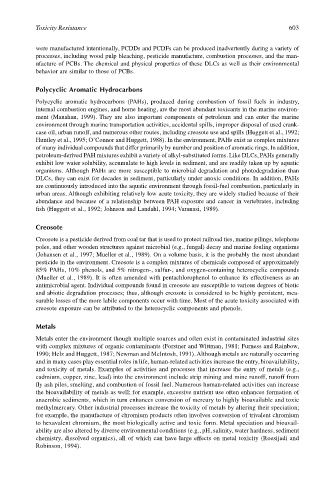Page 623 - The Toxicology of Fishes
P. 623
Toxicity Resistance 603
were manufactured intentionally, PCDDs and PCDFs can be produced inadvertently during a variety of
processes, including wood pulp bleaching, pesticide manufacture, combustion processes, and the man-
ufacture of PCBs. The chemical and physical properties of these DLCs as well as their environmental
behavior are similar to those of PCBs.
Polycyclic Aromatic Hydrocarbons
Polycyclic aromatic hydrocarbons (PAHs), produced during combustion of fossil fuels in industry,
internal combustion engines, and home heating, are the most abundant toxicants in the marine environ-
ment (Manahan, 1999). They are also important components of petroleum and can enter the marine
environment through marine transportation activities, accidental spills, improper disposal of used crank-
case oil, urban runoff, and numerous other routes, including creosote use and spills (Huggett et al., 1992;
Huntley et al., 1995; O’Connor and Huggett, 1988). In the environment, PAHs exist as complex mixtures
of many individual compounds that differ primarily by number and position of aromatic rings. In addition,
petroleum-derived PAH mixtures exhibit a variety of alkyl-substituted forms. Like DLCs, PAHs generally
exhibit low water solubility, accumulate to high levels in sediment, and are readily taken up by aquatic
organisms. Although PAHs are more susceptible to microbial degradation and photodegradation than
DLCs, they can exist for decades in sediment, particularly under anoxic conditions. In addition, PAHs
are continuously introduced into the aquatic environment through fossil-fuel combustion, particularly in
urban areas. Although exhibiting relatively low acute toxicity, they are widely studied because of their
abundance and because of a relationship between PAH exposure and cancer in vertebrates, including
fish (Huggett et al., 1992; Johnson and Landahl, 1994; Varanasi, 1989).
Creosote
Creosote is a pesticide derived from coal tar that is used to protect railroad ties, marine pilings, telephone
poles, and other wooden structures against microbial (e.g., fungal) decay and marine fouling organisms
(Johansen et al., 1997; Mueller et al., 1989). On a volume basis, it is the probably the most abundant
pesticide in the environment. Creosote is a complex mixtures of chemicals composed of approximately
85% PAHs, 10% phenols, and 5% nitrogen-, sulfur-, and oxygen-containing heterocyclic compounds
(Mueller et al., 1989). It is often amended with pentachlorophenol to enhance its effectiveness as an
antimicrobial agent. Individual compounds found in creosote are susceptible to various degrees of biotic
and abiotic degradation processes; thus, although creosote is considered to be highly persistent, mea-
surable losses of the more labile components occur with time. Most of the acute toxicity associated with
creosote exposure can be attributed to the heterocyclic components and phenols.
Metals
Metals enter the environment though multiple sources and often exist in contaminated industrial sites
with complex mixtures of organic contaminants (Forstner and Wittman, 1981; Furness and Rainbow,
1990; Helz and Huggett, 1987; Newman and McIntosh, 1991). Although metals are naturally occurring
and in many cases play essential roles in life, human-related activities increase the entry, bioavailability,
and toxicity of metals. Examples of activities and processes that increase the entry of metals (e.g.,
cadmium, copper, zinc, lead) into the environment include strip mining and mine runoff, runoff from
fly ash piles, smelting, and combustion of fossil fuel. Numerous human-related activities can increase
the bioavailability of metals as well; for example, excessive nutrient use often enhances formation of
anaerobic sediments, which in turn enhances conversion of mercury to highly bioavailable and toxic
methylmercury. Other industrial processes increase the toxicity of metals by altering their speciation;
for example, the manufacture of chromium products often involves conversion of trivalent chromium
to hexavalent chromium, the most biologically active and toxic form. Metal speciation and bioavail-
ability are also altered by diverse environmental conditions (e.g., pH, salinity, water hardness, sediment
chemistry, dissolved organics), all of which can have large effects on metal toxicity (Roesijadi and
Robinson, 1994).

